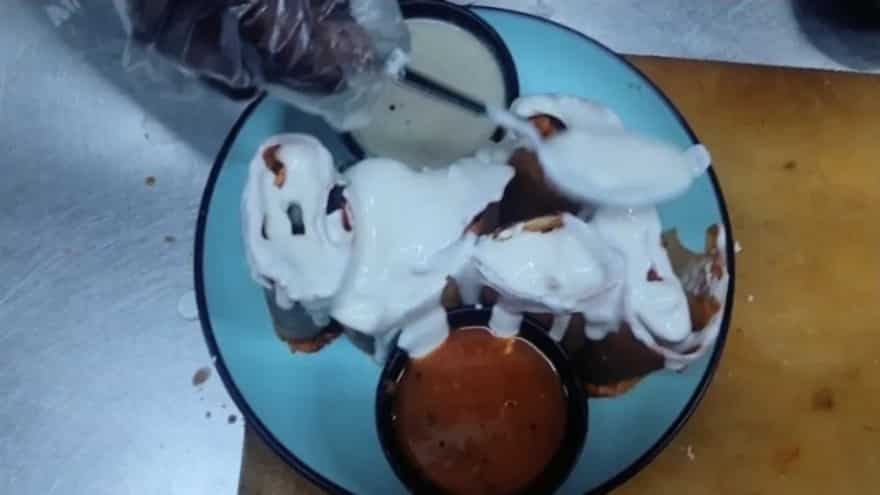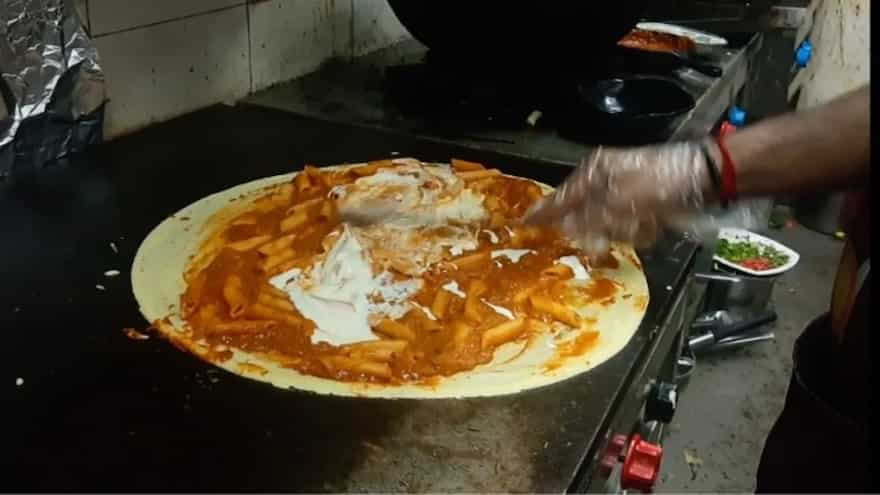Taste, taste, and taste—that was the constant tune of street food sellers everywhere when asked about their usage of cheese in their dishes. But why is that the case? What role does cheese play in India’s street food culture? When did they start using cheese? How has it evolved?
We answer all these and more with the help of Mumbai’s most famous street vendors and India’s famous food journalists.
“Everyone asks for extra cheese, but there is hardly anyone who asks for no cheese.” -Siraj, Cook, at Famous Grill
Siraj, working at the Famous Grill, shared the story of how cheese became a standard ingredient in their Bombay sandwiches. He mentioned that initially, these sandwiches didn't include cheese, but since his tenure at the shop, cheese has become a staple in their offerings. The exact moment they started using cheese seems to have been lost in time.

Cheese's Dominance In Fast Food: Insights From Famous Grill And Amar Juice Centre
Amar Juice Centre has been using cheese in its offerings since its inception 27 years ago. Initially, they used Amul cheese, but they later switched to Govardhan cheese because it maintained its semi-solid texture better, whereas Amul cheese’s present-day counterparts tend to melt quickly.

“We use Govardhan Cheese now as it maintains its semi-solid nature; before that, we used amul cheese, but it melted fast and became too liquid for our dishes.”
-Ramesh Pujari, Manager, Amar Juice Centre
The decision to incorporate cheese was primarily driven by customer demand, and the response has been overwhelmingly positive. Customers have become addicted to the unique taste of Amar Juice Centre's cheese-infused dishes, and it has become an integral part of their menu.
The manager of Amar Juice Centre also noted that their customers either love cheese or hate it.
There’s no in-between. When asked about why it holds such a prominent role in India’s street food culture, he answered that people in general are addicted to the taste of cheese, and there’s nothing equivalent that can take its place.
“People love the taste of cheese, and that's why people flock to it. There’s nothing like it, and that's why it plays such an important role in Indian street food."
Ramesh Pujari, Manager, Amar Juice Centre
Preserving Tradition: Pankaj's Passion For Authentic Vada Pao
Pankaj has been serving vada pao at his shop for the past year, and he has a strong passion for preserving the authenticity of this iconic Indian street food. When asked about the idea of adding cheese to his vada pao, his expression turned noticeably disappointed. He explained that it almost felt like a crime to tamper with the traditional recipe he had cherished since childhood.

He recounted fond memories of enjoying the classic vada pao without any cheese. Pankaj believes that vada pao should remain true to its roots and the rich spices that make it unique. He even mentioned that some customers, usually couples with kids, request cheese vada pao for their children, claiming it's a burger, just to make it more appealing to them. To this, he sighed and questioned the essence of vada pao if one cannot handle its inherent spiciness.
“It feels like a crime to put cheese in vada pao because my whole childhood it was the good old authentic vada pao, and now suddenly people want to change that.” -Pankaj, Owner, Pankaj Vada Pav
He also adds that some young people ask for cheese vada pao because they cannot handle spice. It's worth noting that Pankaj uses Amul cheese in his shop.
Let’s take a sneak peek into the history of cheese in India and what notable food journalist Vir Sanghvi had to say about it.
The Cheese Odyssey In India: A Journey Of Taste And Tradition
Cheese has a relatively recent history in India compared to many other countries. It was not traditionally a part of Indian cuisine due to cultural and dietary preferences. Cheese wasn't consumed much in ancient India, but there is evidence of dairy processing, including the making of a form of cheese, mentioned in ancient texts like the Vedas, dating back over 3,000 years.
The introduction of cheese to India is often attributed to foreign rulers and influences. During the Mughal period (16th to 18th centuries), cheese, particularly paneer (a fresh cheese), gained popularity. Paneer-based dishes like shahi paneer and paneer tikka became part of Indian cuisine. The British colonisation of India also had an impact on cheese consumption. Cheese as we know it today was introduced by the British, and in that period, cheese-making techniques were adapted to suit Indian conditions. British-style cheddar and processed cheeses started to appear.

In the post-independence era, with globalisation and exposure to international cuisines, the consumption of cheese increased. Today, you can find a wide variety of cheeses in India, both imported and locally produced. Indian cheese producers have also begun experimenting with different cheese types and certain regional varieties
Cheese has found its way home to India through its fusion dishes. You'll find dishes like cheese dosa, cheese naan, cheese-filled pav bhaji, cheese vada pav, maggi, and much more. Its popularity continues to grow, especially in urban areas and among the younger generation. It's now a versatile ingredient in both traditional and contemporary Indian cuisine.
Cheese's Evolution In Indian Street Food: Insights From Vir Sanghvi
Cheese is a common ingredient and is found in various non-traditional Indian street foods. Street vendors often incorporate cheese into their offerings to enhance flavour and appeal to the taste preferences of Indian consumers. Cheese is used in street food to provide a rich dairy taste, similar to cream, which is particularly appreciated in North Indian cuisine. It adds creaminess, animal (dairy) fat, and flavour to dishes. Many tandoori/kebab restaurants use cheese in their cooking.
For example, the murgh malai kebab and chicken kadak seekh are enriched with cheese in their marinades. The use of cheese in Indian street food has evolved. While cheese was not readily available in India in the past, it started to gain popularity, particularly in five-star hotels, where chefs experimented with incorporating cheese into kebabs.
“It may be the stealthiest food boom in recent times. But, though we don't talk about it enough, cheese is now flying off the shelves in India. Some estimates say that the cheese market is growing at around 20 percent per year.” -Vir Sanghvi, Senior Journalist and Author of Rude Food
Indian fast food vendors have embraced the concept of "dairy-fication," adding cheese to a variety of dishes, including pav bhaji, dosas, and more, to cater to the Indian preference for dairy fat. The popularity of cheese in Indian street food is also influenced by the pizza sector, where cheese, particularly mozzarella, is a key ingredient. Mozzarella's fresh taste complements many Indian dishes. Some artisanal cheese makers in India are creating non-dairy cheese alternatives with unique flavours, meeting the evolving demands of consumers and sometimes playing an equally important role in Indian dishes.
One could summarise Vir Sanghvi sees cheese as playing a significant and evolving role in Indian street food.
“In outlets like Bhai Omelette Centre, the cheese is almost as important as the eggs.” -Vir Sanghvi, Senior Journalist and Author of Rude Food
Adapting To Customer Demand: The Introduction Of Cheese In BRK Canteen's Maggi
BRK Canteen, a 50-year-old establishment, began offering cheese in their Maggi dishes just a couple of decades ago in response to customer requests. At first, Ajay was still determining how to incorporate cheese into Maggi, but he quickly adapted to meet the demand.
While there are still some customers who prefer plain Maggi, BRK Canteen has built a strong customer base for their cheese Maggi, which cherishes its taste. It's clear that the addition of cheese has been well-received and has become a popular choice among their patrons.
"Initially, I didn't know how to do what they were asking for (adding cheese to maggi). But then eventually, I understood what the customer's demand was and adapted and changed my menu.” -Ajay, Cook, BRK Canteen
Pure Milk And Snack Centre: A Commitment To Innovation

The Pure Milk and Snack Centre, with 30-35 years of experience in the business and 17 years in fast food, initially started their venture to attract customers. They introduced cheese burst options about 1.5 years into their journey, inspired by the widespread use of cheese in the industry.

Experimentation led them to create their cheese variants, primarily using mozzarella. Cheese burst items, particularly the French fries with cheese burst, have gained immense popularity among their diverse clientele. With eight cheese burst variations, they aim to cater to every taste preference while also offering size options. Abhishekh, the manager of Pure Milk and Snack Centre in Ghatkopar, added that their self-made liquid cheese and its quality and taste are the reason for the outlet's success.
“We wanted to stand out; that’s why we started experimenting with cheese, and after 1.5 years of serving normal cheese dosa, we succeeded with cheese burst dosa, and that’s when the customers started rolling in, as it doesn’t happen anywhere else.” -Santosh, Captain at Pure Milk and Snack Centre

Their commitment to offering something unique and their understanding of the love for cheese among customers have made cheese an integral part of their offerings, solidifying its presence on their menu. For them, cheese plays an important role in helping them stand out and make their brand statement.
“We always have greater demand for our cheese burst dishes than their normal counterparts." -Santosh, Captain at Pure Milk and Snack Centre

Overall, cheese has entered various Indian street food establishments due to customer demand and the desire to offer something unique. While some vendors, like Pankaj, remain purists when it comes to preserving traditional flavours, others have fully embraced the addition of cheese, such as Amar Juice Centre and Pure Milk And Snack Centre. Cheese has become a staple ingredient in many Indian fast-food items, reflecting the evolving tastes and preferences of customers.
In summary, cheese overall has found its way into Indian street food due to its ability to enhance flavour, provide creaminess, and cater to the preference for dairy-rich tastes. Some use it to meet public demand; some started out as early adopters; others did it to stand out and experiment; and for some, it’s a begrudging compromise to keep up with the newest trends.
From its basic look that has served Amar Juice Centre well to Pure Snack and Milk Centre to Pankaj Vada Pav, it presents like clay to evolve and adjust to what the present-day scenario demands of its customers or makers' wishes. It also continues to be a significant ingredient in various street food offerings, contributing to the cheese boom in India's culinary landscape.


